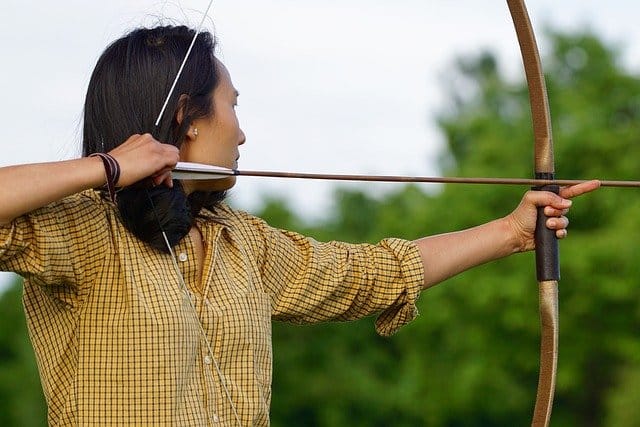Go straight to the Arrow Weight Calculator – CLICK HERE
or
Go straight to the Grains-to-Grams converter (or vice versa) – CLICK HERE
You need an arrow weight calculator, so you come to the right place. Below, you get a simple and free arrow weight calculator. Just punch in the numbers, and you get the total arrow weight in grams, grains and even pounds.
An arrow’s weight is measured in grains or grams. Most likely in grains because it is a very precise measurement. And when weighing arrows, you need a very precise weight because a heavy arrow is not that much heavier than a light arrow.
When you’re an archer, you know the importance of having the right equipment. One vital piece of equipment is your arrow. Not only does it need to be the right length for your bow, but it also needs to be properly weighted.
If an arrow is too light, it will lose inertia quickly and will be less accurate. If it’s too heavy, it will be more difficult to draw and will cause the string to vibrate more, again affecting accuracy.
So how do you know what weight arrow to use and how to calculate it?
The best way is to actually weigh your arrow. This can be done by using a kitchen scale or a digital scale made specifically for arrows. Once you know the weight of your arrow, you can fine-tune your equipment to help ensure that every shot hits its mark.
Key Takeaways
- Mastering a professional arrow weight calculator helps archers customize their setup for greater accuracy and performance.
- Understanding the results of using an Arrow Weight Calculator to calculate kinetic energy and momentum is beneficial for achieving optimal arrow flight and accuracy.
- Entering information into the Arrow Weight Calculator provides tailored results that optimize bow setup, taking into account speed, kinetic energy, length & size of arrows & bows.

Use my Arrow Weight Calculator
An arrow weight calculator is a useful tool if you are trying to figure out the optimal weight for your arrows. There are a number of factors that can affect the accuracy and distance of an arrow, and the weight is an important one. An arrow weight calculator can help to take some of the guesswork out of the process by providing guidance based on the specific specs of the arrow. With this information, archers can make small adjustments to fine-tune their equipment until they achieve the perfect setup for their needs.
This arrow weight calculator can also measure the weight of an arrow in grams.
Or you can find a Grains-to-Grams weight converter below the arrow weight calculator.
Grains to Gram converter | Grams to Grains converter
Use this weight converter to convert Grains-to-Grams or Grams-to-Grains.
What parts of an arrow do you actually weigh?
The weight of an arrow is determined by the sum of its component parts, including the shaft, fletching, nock, and point. The shaft is the main body of the arrow and is typically made from either wood or carbon fiber. The fletching is the feathers or vanes that are attached to the shaft and help to stabilize the arrow in flight. The nock is the notch at the back of the arrow that holds it in place on the bowstring. The point is the sharp tip of the arrow that penetrates the target. When choosing an arrow, it is important to consider the weight of each of these components in order to ensure that the arrow is balanced and will fly straight.
Do you know what weight your arrow should actually have?
How to measure arrow weight
As mentioned, measuring the weight of your arrows is an important part of choosing the right arrows for your bow. Luckily, it’s easy to do with a simple kitchen scale.
First, find the point where the arrow meets the shaft. This is typically about halfway down the arrow.
Next, place the arrow on the scale so that the point is resting on the platform. Be sure to support the shaft so that it doesn’t bend.
Finally, take a reading and multiply by two to get the total weight of the arrow. Now that you know how to measure arrow weight, you can be sure to choose arrows that are the right weight for your bow.
Mastering Your Arrow Weight Calculator
Proficiency with your arrow weight calculator can significantly enhance your archery experience. Knowing the exact weight of your arrow is pivotal in tailoring your arrow setup to your specific needs.
Factoring in components like the shaft, point, insert, vanes, and insert collar weight permits optimization of arrow velocity, kinetic energy, and penetration potential.
Entering Your Arrow Components
For precise calculations, it’s crucial to measure the weight of each arrow component, encompassing the:
- shaft
- point
- insert
- vanes
- wrap length
The weight of an arrow shaft, for example, depends on factors like vane length and usually ranges between 8-11 grains per inch. Meanwhile, a three-fletch configuration with plastic hunting vanes on an arrow typically weighs between 15-30 grains.
The dynamic arrow spine is also significant, impacting the arrow shaft’s flex upon release from the bow and modifying the center balance.
Understanding the Results
Selecting a shaft with a suitable spine for your draw weight and draw length is beneficial for achieving the best arrow flight and accuracy. The Arrow Weight Calculator provides essential information, including the total arrow weight, which comprises the shaft, fletching, and any extra components like inserts or nocks.
To calculate kinetic energy, the formula generally used is 1/2 Mass (Arrow Weight in grains divided by 2) x Velocity squared (Arrow Speed x Arrow Speed). Kinetic energy in archery refers to the energy an arrow has due to its mass and speed.
Furthermore, the calculator computes momentum using the values of arrow velocity and mass.
Making Adjustments
In the process of adjusting arrow components, take into account aspects such as:
- Arrow length
- Weight
- Spine
- Fletching configurations
- Nock tune and index
Modifying the arrow weight can have various effects on its performance, with heavier arrows generally being slower but more stable and offering better penetration power. To adjust the fletching weight for optimal performance, you can manipulate the tip weight by increasing or decreasing it, affecting the arrow’s flight, speed, accuracy, and penetration.
You can also alter the arrow’s nock weight in the calculator, influencing the overall weight and balance of the arrow. Adjusting the broadhead weight involves substituting the broadhead with a heavier or lighter one, or adding or removing weight from the existing broadhead, to influence the flight and accuracy of the arrow.
The Dynamics of Arrow Spine and Weight
The interplay between arrow spine and weight significantly impacts your arrow’s performance. Comprehending the dynamics of arrow spine and weight aids in choosing the appropriate arrow weight for your particular needs, be it hunting diverse game or shooting in varying environmental situations.
Arrows with lower spines typically weigh less than those with more rigid spines.
Evaluating Shaft Weight Categories
Arrow shafts fall into three weight categories: light, medium, and heavy. Each weight class comes with distinct performance characteristics. Light arrow shafts generally weigh less than 400 grains, medium ones between 400 and 500 grains, and heavy shafts usually exceed 500 grains. Employing smaller diameter shafts can decrease wind resistance and friction upon impact with the target, leading to increased accuracy and deeper penetration.
The weight of the shaft can also influence the flight trajectory of an arrow, with heavier arrows tending to have a flatter trajectory and higher penetration potential, while lighter arrows tend to have a faster but more curved trajectory.
Impact of Additional Weight
Increased arrow weight can have several effects on bow performance:
- Enhance bow efficiency
- Flatten the trajectory
- Potentially lower speed
- Lengthen the distance covered with higher draw weight
Additional arrow weight also has positive effects on kinetic energy and penetration. The higher weight increases the arrow’s kinetic energy and momentum, both contributing to penetration.
A heavier arrow necessitates a higher draw weight to generate the same velocity as a lighter arrow. Arrow weight can significantly influence shooting accuracy, with heavier arrows providing more stability during flight and lighter arrows having a faster but more curved trajectory.
Selecting the Right Vane and Nock Weight
The selection of suitable vane and nock weight is pivotal in maintaining an accurate arrow spine and balance. Factors such as:
- length
- shape
- size
- color
- spine
- weight
- durability
- weather resistance
Taking the vanes bushing weight into consideration is crucial when deciding on vane and nock weight. The weight of the vane and nock affects the balance of an arrow by adding weight to the rear of the shaft, altering the dynamic spine and increasing drag.
Vane weight does affect an arrow’s velocity, with heavier vanes stiffening the spine and reducing flexure, thus leading to increased speed, while lighter vanes can shift the balance point forward and may lead to a reduction in speed.
Customizing Arrows for Hunting Success
Tailoring your arrows for successful hunting necessitates tweaking point and broadhead weight, integrating insert collar and wrap weight, and calculating for wooden arrows.
Utilizing field points and broadheads with equivalent weights guarantees uniform flight trajectory, velocity, and effect between practice and hunting scenarios.
Adjusting Point and Broadhead Weight
The point and broadhead components of an arrow serve to enable penetration and inflict damage on the target, respectively. Tweaking point and broadhead weight proves crucial in obtaining the preferred arrow performance in certain hunting situations.
The steps for adjusting point and broadhead weight involve selecting an appropriate point and broadhead for the arrow, ascertaining the desired arrow weight, and adjusting the weight of the point and broadhead accordingly.
Incorporating Insert Collar and Wrap Weight
Insert collars and wraps can be utilized to add insert weight to the arrow shaft, allowing for customization of the arrow weight for improved performance. Arrow insert collars can be constructed from:
- Aluminum
- Brass
- Stainless steel
- Titanium
The material selected impacts not only the overall weight of the arrow but also its point weight.
Arrow wraps can result in an increase of overall arrow weight, which can also affect the finished arrow weight, arrow mass, and arrow weights, of up to 5-10 grains.
Calculating for Wood Arrows
Traditional wood arrows have unique characteristics that influence their weight, such as the density and mass of the wood, dimensions of the arrow, and point and fletching weight. Calculating wood arrow weight involves considering the draw weight of the bow, arrow spine, and grains per inch (GPI) of the arrow shaft, with the weight of wood potentially varying depending on the type of wood used.
The length of wood arrows also affects their weight, with shortening the arrow length increasing its spine, and lengthening the arrow decreasing the spine.
Fine-Tuning Arrow Length and Weight for Maximum Efficiency
Precise measurement of arrow components and a balance between speed and kinetic energy are vital in optimizing your arrow’s length and weight for utmost efficiency.
Entering the required information into the Arrow Weight Calculator will provide a tailored experience and personalized results, ensuring that you achieve the best performance for your specific needs.
Importance of Accurate Measurement
In archery, precise measurement is of paramount significance for various reasons, not least of which is determining the length and size of arrows and the size of the bow – essential factors in achieving correct form and superior performance. Precise measurement of arrow components such as weight and spine is essential for maximizing performance and ensuring arrows are properly matched to the bow, leading to consistent and accurate shots.
For precise measurement, the following tools are required: Arrow Straightener, Measuring Tape or Ruler, Digital Scale, and Calipers.
Balancing Speed and Kinetic Energy
A direct proportionality exists between arrow speed and kinetic energy, implying that faster arrows possess more kinetic energy, thereby enhancing penetration and impact efficacy. The mass of an arrow also affects its kinetic energy, with heavier arrows having more kinetic energy than lighter arrows traveling faster.
Lighter arrows lose velocity faster downrange, while heavier arrows are more effective at longer distances.
Enter Required Information for a Tailored Experience
To obtain a tailored experience with the Arrow Weight Calculator, you must supply the arrow’s length, diameter, and grain per inch (GPI). The calculator uses this information to calculate the total weight of the arrow, which is significant for determining factors such as arrow speed, trajectory, and kinetic energy.
The calculator tailors the results per the input data, thereby furnishing a more accurate estimate of the arrow weight and aiding in fine-tuning the bow setup.
How to change the weight of an arrow?
If you are not satisfied with the performance of your arrows, changing the weight is a relatively simple process that can be done with a few basic tools.
First, remove the arrowhead and fletching. Then, use a scale to weigh the shaft and determine how much weight needs to be added or removed. Once you have determined the desired weight, you can add weight by gluing on brass inserts or carefully removing material from the shaft with a rasp.
Finally, reattach the arrowhead and fletching and test-shoot the arrow to check its flight characteristics. By following these simple steps, you can easily change the weight of your arrows to suit your needs.
How to change the overall arrow weight
Choosing the right arrow is finding the perfect balance of weight and durability. If an arrow is too light, it will not have enough kinetic energy to penetrate deep into the target. On the other hand, if an arrow is too heavy, it will be difficult to control and may cause inaccuracies.
One common method of changing arrow weight is by changing the type of shaft material. For example, arrows made from carbon fiber are typically lighter than those made from aluminum. As a result, carbon fiber arrows are often used for hunting, as they can be shot with more speed and accuracy.
Another way to change arrow weight is by adding or removing fletching. The fletching is the feathers or plastic vanes attached to the back end of the arrow, and they help to stabilize the flight of the arrow. By removing fletching, you can decrease drag and wind resistance, making the arrow lighter and easier to control.
Finally, you can also add weight to an arrow by attaching a weight to the front end of the shaft. This helps to increase penetration power, but it also makes the arrow more difficult to control. Ultimately, finding the right method of changing overall arrow weight is a matter of experimentation and personal preference.
Final Thoughts
In conclusion, mastering the Arrow Weight Calculator and understanding the dynamics of arrow spine and weight are essential to achieve optimal arrow performance. Customizing your arrows for hunting success and fine-tuning arrow length and weight for maximum efficiency will help you unlock the true potential of your equipment. By taking the time to accurately measure components, balance speed and kinetic energy, and enter the required information into the calculator, you can create the perfect arrow setup tailored to your specific needs.
Frequently Asked Questions
Why are arrows measured and weighed in grains?
Arrows are typically measured in grains, with one grain being equivalent to 0.065 grams (1/7000th of a pound). The grain is the unit of measurement for mass in the imperial system, and it is used for arrows because of its small size. One pound equals 7,000 grains, so a single grain is quite tiny.
However, when dealing with something as small and light as an arrow, even a single grain can make a difference. That’s why arrows are weighed in grains, in order to get a more accurate measure of their mass.
This allows archers to fine-tune their equipment and choose the perfect arrow for their needs. In addition, measuring arrows in grains also makes it easier to compare different types of arrows and choose the ones that will perform the best.
How heavy should my arrow be?
For bows in the 70-lb. range, start with 6 grains of arrow weight per pound of draw weight, while for bows in the 60-lb range, use 8 grains of arrow weight per pound of draw weight.
What is the difference between a 300 and 400 arrow?
The difference between a 300 and 400 arrow is that the higher number indicates a heavier and stiffer arrow shaft.
What spine arrow do I need for 70 lb bow?
For a 70 lb bow with 29.5 draw length, you should choose a spine arrow between 300-350 for hunting, with heavier arrows up front to soften the spine.
What is the best arrow point weight?
The best arrow point weight for target archers is typically heavier than normal, ranging from 140 to 300 grains, as the momentum of a heavier point helps pull the arrow through the air for improved accuracy.
How to calculate foc?
To calculate Forward of Center (FOC), first divide the arrow’s overall length by two. Then, find the arrow balance point and subtract from the center of the arrow measurement. Finally, multiply this result by 100 to calculate FOC.
How much are 100 grains?
If each grain is equivalent to 0.065 grams (1/7000th of a pound), then 100 grains would be approximately 6.5 grams (0.01433 pounds).
Grains > Grams > Pounds
- 100 grains = 6.5 grams = 0.01433 pounds
- 200 grains = 13 grams = 0.02866 pounds
- 300 grains = 19.5 grams = 0,04299 pounds
- 400 grains = 26 grams = 0.05732 pounds
- 500 grains = 32.5 grams = 0,07165 pounds
- 600 grains = 39 grams = 0,08598 pounds
How much does a light arrow weigh?
A light arrow weighs about 350 to 400 grains = 22.7 – 26 grams.
How much does a standard arrow weigh?
A standard arrow weighs about 400 to 460 grains = 26 – 29.8 grams.
How much does a heavy arrow weigh?
A heavy arrow weighs about 460 grains or more = 29.8 grams and up.
What does GPI mean?
What exactly does GPI mean? GPI stands for “grains per inch,” and it’s a way of measuring the weight of an arrow.
To calculate the GPI of an arrow, simply divide the arrow’s total weight (in grains) by its length (in inches). The resulting number will give you the arrow’s GPI.
For example, if an arrow is 20 inches long and weighs 400 grains, its GPI would be 20. The higher the GPI of an arrow, the heavier it is.


